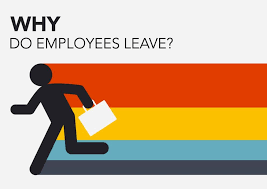
Reasons for mass employee turnover and how to stop them
Related post


Jemima Abel
June 15, 2025
As an organization, people are your biggest asset and while you’ll never eliminate employee turnover, there are ways to reduce it.
What is employee turnover?
Employee turnover is defined as the number of employees that exit an organization during a given period of time. This may be voluntary or involuntary, but as long as an employee is replaced with another, there is a turnover.
Why do employees leave their jobs?
Several factors can contribute to employee turnover. While the reasons for leaving may resonate differently with different people, there are chances few of your employees leave for these reasons. Here are 10 common reasons why employees leave their jobs.
-
Lack of work-life balance
Having time for friends, family, and loved ones is a great way to balance life, but when employees constantly receive calls and tasks from managers even after work hours, it’ll impact their personal time and make them feel burnt out. Excessive workload, long work hours, and lack of flexibility can lead to the exit of an employee.
2. Workplace loneliness leads to employee turnover.
Working with uptight people or people that make them feel like they don’t belong adds to a decision to exit an organization.
Humans are social creatures and general belonging is something every human craves. It’s an imperative for managers to make employees feel a sense of safety and belonging in the organization.
3. Inadequate compensation leads to employee turnover
When employees feel they are underpaid in the job they do, it may be the right cue to move on to a new job, especially when there is an offering. Likewise, they may be able to accept more responsibilities and with that comes more pay.
Whenever an employee feels their compensation doesn’t reflect their skills, experience, or the market value of their role, it could cause big problems.
Sure, money isn’t everything, but it’s a tangible measure of how much a company values its employees.
4. Feeling uninspired and less valued can influence employee turnover
What started as an interesting opportunity may eventually leave employees uninspired over time. Finding a new job can be more challenging and it can be a great way to feel inspired, especially in a place where employees feel less valued.
Often times, managers make employees feel like they are replaceable and this makes employees look for organizations where their efforts are recognized.
5. No or unclear expectations.
In some organizations, employees don’t know what height to attain before they are tagged “successful.” This makes them do a lot with their time and effort without a focused goal in mind.
6. Lack of training leads to employee turnover
Training doesn’t just help employees grow or learn new skills. It also helps keep them motivated and around as they see opportunities to grow and be better in their field.
A lack of training options can leave employees feeling stagnant and often lead them to look for better options.
7. Poor management
A terrible manager gives more than a headache. Think of an organization that micromanages you and doesn’t give you the freedom to express your creative self, lacks communication or correction and then shows favoritism. This impacts negatively on the employee morale and leads to burnout, decreased productivity, and huge employee turnover.
8. Better opportunities
This reason for employee turnover is obviously not the organization’s fault because there will always be better opportunities, especially when it’s a highly valued employee.
9. Other employees are leaving
Even if they’re not close friends with them, it can be a wake-up call to them and everyone in the company.
They may ask themselves, “If everyone is leaving, then it’s not a good space to be in even though I’m not seeing it.”
This means that even employees that are not at risk now become at risk just out of curiosity or fear that it’s a sinking ship.
10. Not enough flexibility
Since the COVID year, when remote jobs were widely circulated, employees will choose a flexible schedule or remote work options.
Employees also want the freedom to adjust work schedules and won’t just stay with an organization that “wants to see them all day or still tells them what to do.”
Signs an employee is about to leave an organization.
While you can predict when an employee is leaving, there will be signs before wonders. Being aware of these signs can help managers anticipate and maybe block the resignation before it lands on their table.
- Decreased productivity: Work output drops, deadlines aren’t met, and the standard of deliverables begins to decline
- Increased LinkedIn activity: A noticeable uptick in LinkedIn usage, like profile updates or frequent recruiter connections, may indicate they’re actively exploring new job opportunities.
- A major event in their personal life: Significant personal developments—such as health issues, family responsibilities, or other life changes—can often prompt someone to consider a new career path.
- Frequent time off: An unusual spike in sick days or personal leave could point to them attending job interviews or exploring other opportunities.
- Social disengagement: They’re less active in meetings, skip workplace social events, and generally appear detached from team interactions.
- Lack of ambition: They show minimal enthusiasm for growth, promotions, or skill-building—suggesting they no longer envision a future with the company.
- Unreasonable demands: Requests for major salary increases or role changes that don’t align with company norms may be a way of testing boundaries—or preparing to leave.
- Using up leave quickly: Rapidly exhausting vacation days may be a signal they’re planning to resign and want to use their time off before doing so.
How to reduce employee turnover.

1. Accept the status quo is not working
Just because you’re satisfied with the growth of the company doesn’t mean others are. If people are leaving, it’s a huge signal that there’s a problem to be dealt with. Be open to their feedback and issues they bring up. The solutions may be difficult, but realize that it’s either you provide a solution or lose your employee
2. Embrace honest one-on-ones
There is usually not “one” reason why employees will decide to leave at a given period of time. It takes alot to apply for jobs, attend interviews, and pray to get the job. Often times, it’s more than one problem.
You must prioritize giving plenty of time for people to air their grievances. Start having one-on-ones with everyone on the team biweekly or monthly and ensure all issues raised are addressed.
3. Follow through and take actions.
The best way to build trust with people that might leave is to take action on the feedback they give you. You may not be able to fix all the problems but even small incremental progress can improve people’s morale and attitude.
4. Invest in employee retention strategies.
Employee turnover is a sign that employees are not satisfied and if people are great assets in your organization, it’s important to invest in them. Recognize their little wins. Host team-bonding sessions, host work-life balance sessions, and pay for trainings. It’s important to allocate time and resources as you go.
In conclusion,
At the end of the day, employee turnover is a fact of life.
Sometimes, even after you try to understand “reasons for mass employee turnover” in your organization, an employee will leave. Maybe they found a dream role elsewhere, a better benefit, or perhaps they are seeking a completely different path in life.
But while you can’t eliminate turnover entirely, you can significantly reduce it by creating a company culture where employees feel valued, supported, and inspired to grow.
That’s where YellowLyfe comes in. As a premier team bonding and event production company, YellowLyfe specializes in creating meaningful experiences that strengthen workplace connections, boost morale, and reignite employee engagement.
From customized retreats and team-building activations to inspiring corporate events, YellowLyfe helps companies invest in their people—not just with words, but with action. Because when employees feel valued and connected, they’re far more likely to stay—and thrive.

